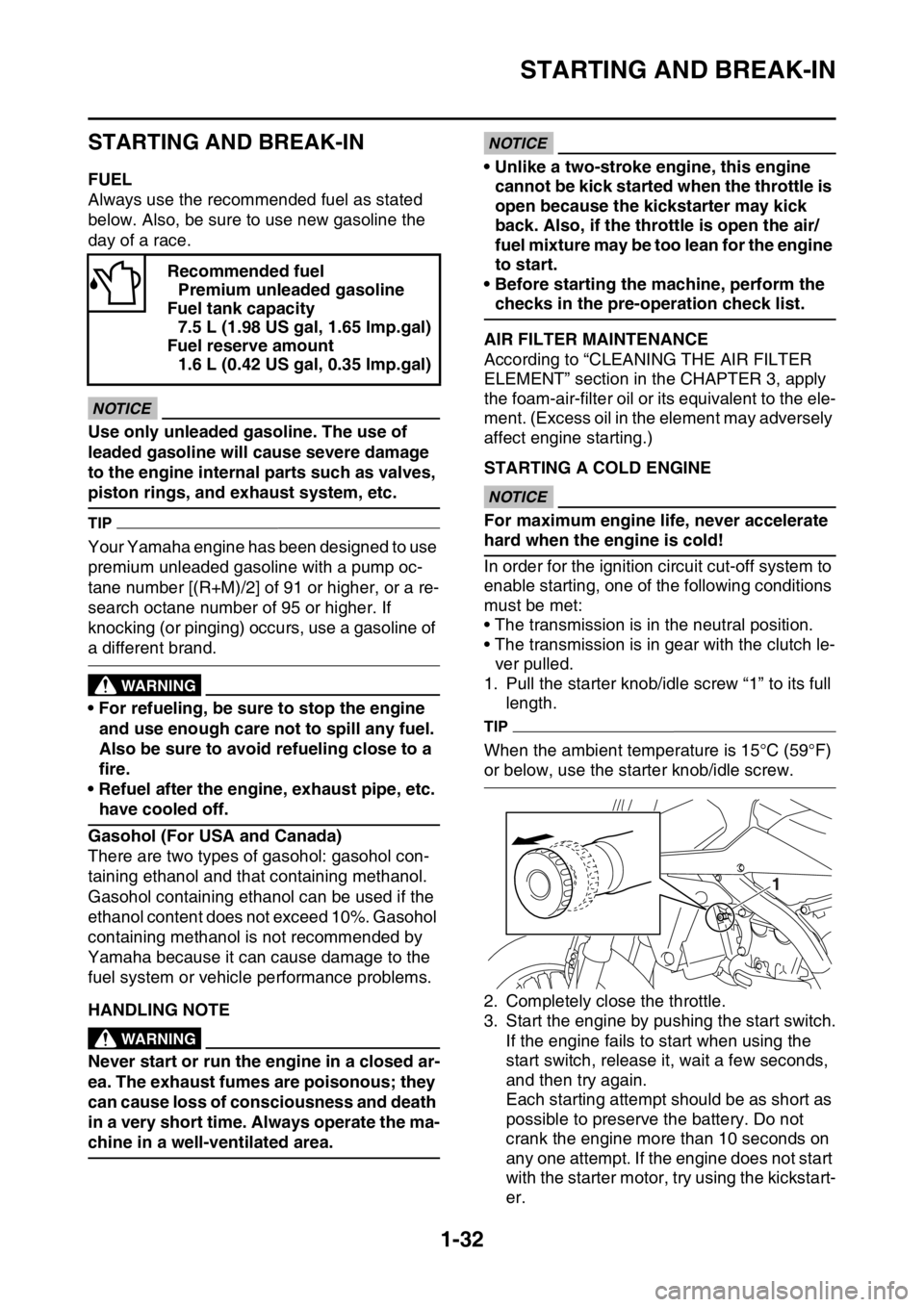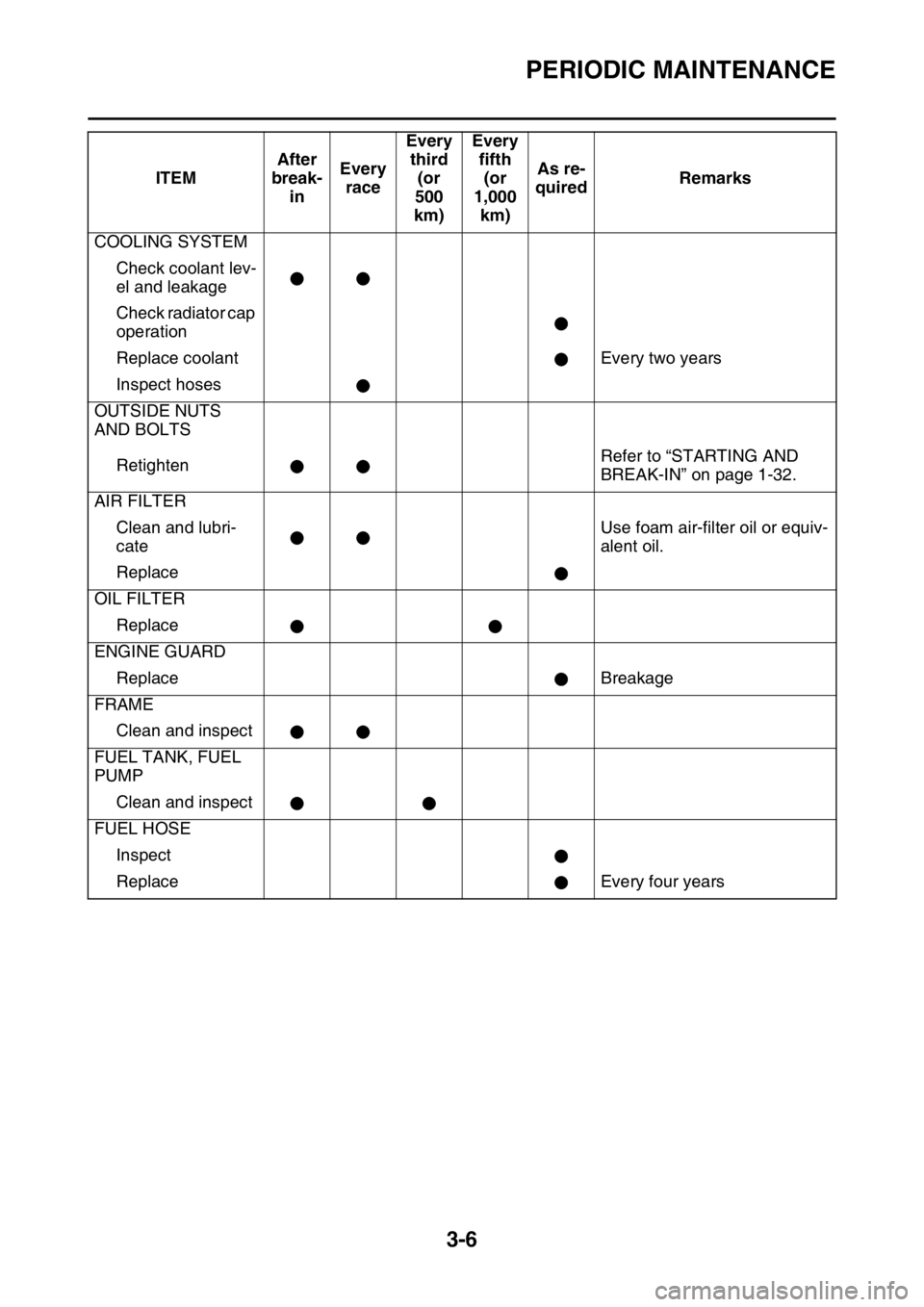fuel filter YAMAHA WR 250F 2015 Owners Manual
[x] Cancel search | Manufacturer: YAMAHA, Model Year: 2015, Model line: WR 250F, Model: YAMAHA WR 250F 2015Pages: 430, PDF Size: 14.14 MB
Page 14 of 430

CONTROL FUNCTIONS................................................................................ 1-21
INDICATOR LIGHTS AND WARNING LIGHTS ....................................... 1-21
ENGINE STOP SWITCH .......................................................................... 1-21
START SWITCH....................................................................................... 1-21
CLUTCH LEVER...................................................................................... 1-21
SHIFT PEDAL .......................................................................................... 1-22
KICKSTARTER LEVER............................................................................ 1-22
THROTTLE GRIP ..................................................................................... 1-22
FRONT BRAKE LEVER ........................................................................... 1-22
REAR BRAKE PEDAL.............................................................................. 1-22
SIDESTAND ............................................................................................. 1-23
STARTER KNOB/IDLE ADJUSTING SCREW ......................................... 1-23
FUEL TANK CAP ..................................................................................... 1-23
MULTI-FUNCTION DISPLAY......................................................................... 1-24
DESCRIPTION ......................................................................................... 1-24
BASIC MODE ........................................................................................... 1-24
CHANGEOVER TO BASIC MODE/RACE MODE.................................... 1-25
RACE MODE ............................................................................................ 1-26
FUNCTION DIAGRAM ............................................................................. 1-30
STARTING AND BREAK-IN.......................................................................... 1-32
FUEL ........................................................................................................ 1-32
HANDLING NOTE .................................................................................... 1-32
AIR FILTER MAINTENANCE ................................................................... 1-32
STARTING A COLD ENGINE .................................................................. 1-32
STARTING A WARM ENGINE ................................................................. 1-33
BREAK-IN PROCEDURES ...................................................................... 1-34
MAINTENANCE AFTER BREAK-IN.............................................................. 1-35
MAJOR MAINTENANCE .......................................................................... 1-35
TORQUE-CHECK POINTS............................................................................ 1-36
MOTORCYCLE CARE AND STORAGE........................................................ 1-38
CARE........................................................................................................ 1-38
STORAGE ................................................................................................ 1-39
Page 18 of 430

DESCRIPTION
1-4
EAS2GB2009
DESCRIPTION
TIP
Designs and specifications of the vehicle are subject to change without notice. Therefore, please
note that the descriptions in this manual may be different from those for the vehicle you have pur-
chased.1. Clutch lever 12. Headlight
2. Multi-function display 13. Radiator
3. Front brake lever 14. Coolant drain bolt
4. Throttle grip 15. Rear brake pedal
5. Start switch 16. Air filter
6. Radiator cap 17. Drive chain
7. Fuel tank cap 18. Shift pedal
8. Engine stop switch 19. Oil level check window
9. Taillight 20. Starter knob/idle screw
10. Fuel tank 21. Front fork
11. Kickstarter lever
32 1
8
10
91112 1376
54
15 14 21 20 19 18 1716
Page 21 of 430

FEATURES
1-7
EAS2GB2015FI SYSTEM
The fuel pump delivers fuel to the fuel injector via the fuel filter. The pressure regulator maintains the
fuel pressure that is applied to the fuel injector at only 324 kPa (3.24 kgf/cm
2, 47.0 psi). Accordingly,
when the energizing signal from the ECU energizes the fuel injector, the fuel passage opens, causing
the fuel to be injected into the intake manifold only during the time the passage remains open. There-
fore, the longer the length of time the fuel injector is energized (injection duration), the greater the
volume of fuel that is supplied. Conversely, the shorter the length of time the fuel injector is energized
(injection duration), the lesser the volume of fuel that is supplied.
The injection duration and the injection timing are controlled by the ECU. Signals input from the throt-
tle position sensor, the coolant temperature sensor, the crankshaft position sensor, the intake air
pressure sensor, and the intake air temperature sensor enable the ECU to determine the injection
duration. The injection timing is determined through the signals from the crankshaft position sensor.
As a result, the volume of fuel that is required by the engine can be supplied at all times in accordance
with the driving conditions.
1. Fuel pump
2. Fuel injector
3. ECU
4. Throttle position sensor
5. Coolant temperature sensor
6. Crankshaft position sensor
7. Intake air pressure sensor
8. Throttle body
9. Intake air temperature sensor
10.Air filter case
A. Fuel system
B. Intake system
C. Control system
1
23
5
6 7
8 9 10A
BC
4
Page 46 of 430

STARTING AND BREAK-IN
1-32
EAS2GB2050
STARTING AND BREAK-IN
EAS2GB2051FUEL
Always use the recommended fuel as stated
below. Also, be sure to use new gasoline the
day of a race.
ECA
NOTICE
Use only unleaded gasoline. The use of
leaded gasoline will cause severe damage
to the engine internal parts such as valves,
piston rings, and exhaust system, etc.
TIP
Your Yamaha engine has been designed to use
premium unleaded gasoline with a pump oc-
tane number [(R+M)/2] of 91 or higher, or a re-
search octane number of 95 or higher. If
knocking (or pinging) occurs, use a gasoline of
a different brand.
EWA
WARNING
• For refueling, be sure to stop the engine
and use enough care not to spill any fuel.
Also be sure to avoid refueling close to a
fire.
• Refuel after the engine, exhaust pipe, etc.
have cooled off.
Gasohol (For USA and Canada)
There are two types of gasohol: gasohol con-
taining ethanol and that containing methanol.
Gasohol containing ethanol can be used if the
ethanol content does not exceed 10%. Gasohol
containing methanol is not recommended by
Yamaha because it can cause damage to the
fuel system or vehicle performance problems.
EAS2GB2052HANDLING NOTEEWA
WARNING
Never start or run the engine in a closed ar-
ea. The exhaust fumes are poisonous; they
can cause loss of consciousness and death
in a very short time. Always operate the ma-
chine in a well-ventilated area.
ECA
NOTICE
• Unlike a two-stroke engine, this engine
cannot be kick started when the throttle is
open because the kickstarter may kick
back. Also, if the throttle is open the air/
fuel mixture may be too lean for the engine
to start.
• Before starting the machine, perform the
checks in the pre-operation check list.
EAS2GB2053AIR FILTER MAINTENANCE
According to “CLEANING THE AIR FILTER
ELEMENT” section in the CHAPTER 3, apply
the foam-air-filter oil or its equivalent to the ele-
ment. (Excess oil in the element may adversely
affect engine starting.)
EAS2GB2054STARTING A COLD ENGINEECA
NOTICE
For maximum engine life, never accelerate
hard when the engine is cold!
In order for the ignition circuit cut-off system to
enable starting, one of the following conditions
must be met:
• The transmission is in the neutral position.
• The transmission is in gear with the clutch le-
ver pulled.
1. Pull the starter knob/idle screw “1” to its full
length.
TIP
When the ambient temperature is 15°C (59°F)
or below, use the starter knob/idle screw.
2. Completely close the throttle.
3. Start the engine by pushing the start switch.
If the engine fails to start when using the
start switch, release it, wait a few seconds,
and then try again.
Each starting attempt should be as short as
possible to preserve the battery. Do not
crank the engine more than 10 seconds on
any one attempt. If the engine does not start
with the starter motor, try using the kickstart-
er. Recommended fuel
Premium unleaded gasoline
Fuel tank capacity
7.5 L (1.98 US gal, 1.65 lmp.gal)
Fuel reserve amount
1.6 L (0.42 US gal, 0.35 lmp.gal)
1
Page 57 of 430

ENGINE SPECIFICATIONS
2-2
EAS2GB2064
ENGINE SPECIFICATIONS
Engine
Engine type Liquid cooled 4-stroke, DOHC
Displacement 250 cm
3
Cylinder arrangement Single cylinder
Bore stroke 77.0 53.6 mm (3.0 2.1 in)
Compression ratio 13.5:1
Starting system Electric starter and kickstarter
Fuel
Recommended fuel Premium unleaded gasoline only
Fuel tank capacity 7.5 L (1.98 US gal, 1.65 Imp.gal)
Fuel reserve amount 1.6 L (0.42 US gal, 0.35 Imp.gal)
Engine oil
Lubrication system Wet sump
Recommended brand YAMALUBE
Type SAE 10W-30, SAE 10W-40, SAE 10W-50,
SAE 15W-40, SAE 20W-40 or SAE 20W-50
Recommended engine oil grade API service SG type or higher, JASO standard
MA
Engine oil quantity
Quantity (disassembled) 1.10 L (1.16 US qt, 0.97 Imp.qt)
Without oil filter element replacement 0.83 L (0.88 US qt, 0.73 Imp.qt)
With oil filter element replacement 0.85 L (0.90 US qt, 0.75 Imp.qt)
Oil filter
Oil filter type Paper
Bypass valve opening pressure 40.0–80.0 kPa (0.40–0.80 kgf/cm
2,
5.8–11.6 psi)
Oil pump
Oil pump type Trochoid
Inner-rotor-to-outer-rotor-tip clearance Less than 0.150 mm (0.0059 in)
Limit 0.20 mm (0.0079 in)
Outer-rotor-to-oil-pump-housing clearance 0.13–0.18 mm (0.0051–0.0071 in)
Limit 0.24 mm (0.0094 in)
Oil-pump-housing-to-inner-and-outer-rotor
clearance 0.06–0.11 mm (0.0024–0.0043 in)
Limit 0.17 mm (0.0067 in)
Cooling system
Radiator capacity (including all routes) 1.00 L (1.06 US qt, 0.88 Imp.qt)
Radiator capacity 0.56 L (0.60 US qt, 0.50 Imp.qt)
Radiator cap opening pressure 107.9–137.3 kPa (1.08–1.37 kg/cm
2,
15.6–19.9 psi)
Radiator core
Width 112.6 mm (4.43 in)
Height 235.0 mm (9.25 in)
Depth 28.0 mm (1.10 in)
Water pump
Water pump type Single suction centrifugal pump
Spark plug
Manufacturer/model NGK/LMAR8G
Spark plug gap 0.7–0.8 mm (0.028–0.031 in)
Page 91 of 430

CABLE ROUTING DIAGRAM
2-36
1. Clamp
2. Cylinder head breather hose
3. Throttle position sensor lead
4. Joint coupler
5. Intake air temperature sensor coupler
6. Intake air pressure sensor lead
7. Wire harness
8. Injector lead
9. Throttle body
10. Injector coupler
11. Starter motor lead
12. Plastic band
13. Fuel sender coupler
14. High tension cord
15. Spark plug cap
16. Cylinder head cover
17. Fuel hose
18. Fuel sender
19. Sub-wire harness
20. Crankcase breather hose
21. Radiator breather hose
22. Radiator hose
23. Down tube
24. Starter motor
25. Neutral switch lead
26. AC magneto lead
27. Clutch cable
28. Radiator
29. Air filter case breather hose
30. Breather hose clamp
31. Grommet (high tension cord)
32. ECU
33. Air filter case
34. Sub-wire harness coupler
35. Engine bracket
A. Fix the wire harness, clutch switch lead and start
switch lead by the plastic clamp, and insert the
projection of the plastic clamp into the hole in the
sheet metal of the radiator.
B. Route each lead so that the leads are not pinched
between the tank rail and air filter joint.
C. Insert the projection of the wire harness into the
hole in the frame.
D. Route the cylinder head breather hose without it
crossing the starter motor lead.
E. Pass the cylinder head breather hose between
the throttle cable and rectifier/regulator lead.
F. Connect the sub-wire harness to the wire har-
ness.
G. Pass the high tension cord above the fuel hose.
H. ±10°
I. Install the spark plug cap with this facing the right
of the vehicle.
J. Push the spark plug cap home, where there shall
be no gap between it and the cylinder head cover.
K. Pass the radiator breather hose between the
down tubes.
L. Apply adhesive to the slit and inside of the grom-
met, and then fix the grommet according to the
specified dimensions.
M. Pass the sub-wire harness between the ECU and
the air filter case.
N. Insert the coupler of the sub-wire harness into the
rib of the air filter case.
O. Route the radiator breather hose through be-
tween the radiator hose, down tube and engine
bracket.
Page 93 of 430

CABLE ROUTING DIAGRAM
2-38
1. Cable guide
2. Speed sensor lead
3. Joint coupler
4. Ground lead
5. Throttle position sensor lead
6. Throttle position sensor coupler
7. Radiator breather hose
8. Cylinder head breather hose
9. Crankcase breather hose
10. Radiator hose
11. Fuel hose
12. Engine ground lead
13. Coolant temperature sensor coupler
14. Radiator fan motor lead
15. Intake air pressure sensor coupler
16. Intake air temperature sensor coupler
17. Start switch coupler
18. Radiator fan motor coupler
19. Clutch switch coupler
20. Air filter case
21. Plate
22. Bracket
A. Pass the wire harness under the start switch lead
and clutch switch lead.
B. Insert and fix the joint coupler to the plate. After
fixing it, attach the cover.
C. Pass the throttle position sensor lead to the out-
side of the tension arm (the outside of the vehi-
cle).
D. After connecting the throttle position sensor cou-
pler, attach the cover.
E. Pass the radiator breather hose to the outside of
the tension arm and the throttle position sensor
lead (the outside of the vehicle), and to the inside
of the radiator hose (the side of the vehicle).
F. 45°
G. Install the engine ground lead within a range of
45° from a location where it will not run over the
step difference of the radiator hose joint. Both
sides of the engine ground lead terminal can be
used.
H. Attach the coupler cover to the coolant tempera-
ture sensor coupler.
I. Pass the radiator fan motor lead to the inside of
the tension arm (the side of the vehicle).
J. Install the ground lead terminal between the plate
and the bolt.
K. Fix the ground lead terminal to the detent in the
plate. For the ground lead terminal, either side
will do.
L. Detent
Page 103 of 430

3
PERIODIC CHECKS AND ADJUSTMENTS
PERIODIC MAINTENANCE............................................................................. 3-1
INTRODUCTION ........................................................................................ 3-1
PERIODIC MAINTENANCE CHART FOR THE EMISSION
CONTROL SYSTEM ................................................................................. 3-1
GENERAL MAINTENANCE AND LUBRICATION CHART ........................ 3-2
MAINTENANCE INTERVALS FOR COMPETITION USE ......................... 3-4
PRE-OPERATION INSPECTION AND MAINTENANCE................................. 3-9
GENERAL INSPECTION AND MAINTENANCE........................................ 3-9
ENGINE.......................................................................................................... 3-10
CHECKING THE COOLANT LEVEL ........................................................ 3-10
CHECKING THE COOLING SYSTEM ..................................................... 3-10
CHANGING THE COOLANT.................................................................... 3-10
CHECKING THE RADIATOR CAP .......................................................... 3-11
CHECKING THE RADIATOR CAP OPENING PRESSURE .................... 3-11
CHECKING THE COOLANT CIRCULATORY SYSTEM FOR LEAKS .... 3-12
ADJUSTING THE CLUTCH LEVER FREE PLAY .................................... 3-12
ADJUSTING THE THROTTLE GRIP FREE PLAY .................................. 3-13
LUBRICATING THE THROTTLE CABLE ................................................ 3-13
CLEANING THE AIR FILTER ELEMENT................................................. 3-14
CHECKING THE THROTTLE BODY JOINT ............................................ 3-15
CHECKING THE BREATHER HOSES .................................................... 3-15
CHECKING THE EXHAUST SYSTEM..................................................... 3-15
CHECKING THE FUEL LINE ................................................................... 3-16
CHECKING THE ENGINE OIL LEVEL..................................................... 3-16
CHANGING THE ENGINE OIL ................................................................ 3-17
ADJUSTING THE ENGINE IDLING SPEED ............................................ 3-18
ADJUSTING THE VALVE CLEARANCE ................................................. 3-19
CLEANING THE SPARK ARRESTER ..................................................... 3-23
CHASSIS........................................................................................................ 3-24
BLEEDING THE BRAKE SYSTEM .......................................................... 3-24
CHECKING THE BRAKE HOSE .............................................................. 3-25
ADJUSTING THE FRONT BRAKE .......................................................... 3-25
ADJUSTING THE REAR BRAKE ............................................................. 3-26
CHECKING THE FRONT BRAKE PADS ................................................. 3-26
CHECKING THE REAR BRAKE PADS ................................................... 3-28
CHECKING THE REAR BRAKE PAD INSULATOR ................................ 3-29
CHECKING THE BRAKE FLUID LEVEL.................................................. 3-29
ADJUSTING THE DRIVE CHAIN SLACK ................................................ 3-30
CHECKING THE FRONT FORK LEGS ................................................... 3-31
CHECKING THE FRONT FORK PROTECTOR GUIDE .......................... 3-31
CLEANING THE FRONT FORK OIL SEAL AND DUST SEAL ................ 3-31
AIR BLEEDING FROM FRONT FORK .................................................... 3-31
ADJUSTING THE FRONT FORK LEGS .................................................. 3-32
CHECKING THE SWINGARM OPERATION ........................................... 3-33
CHECKING THE REAR SUSPENSION ................................................... 3-33
Page 105 of 430

PERIODIC MAINTENANCE
3-1
EAS2GB2076
PERIODIC MAINTENANCE
EAS2GB2077INTRODUCTION
This chapter includes all information necessary to perform recommended checks and adjustments.
If followed, these preventive maintenance procedures will ensure more reliable vehicle operation, a
longer service life and reduce the need for costly overhaul work. This information applies to vehicles
already in service as well as to new vehicles that are being prepared for sale. All service technicians
should be familiar with this entire chapter.
EAS2GB2078PERIODIC MAINTENANCE CHART FOR THE EMISSION CONTROL SYSTEM
TIP
• From 4200 mi (7000 km) or 9 months, repeat the maintenance intervals starting from 1800 mi (3000
km) or 3 months.
• Items marked with an asterisk should be performed by a Yamaha dealer as they require special
tools, data and technical skills.
NO. ITEM CHECKS AND MAINTENANCE JOBSINITIALODOMETER READ-
INGS
600 mi
(1000
km) or 1
month1800 mi
(3000
km) or 3
months3000 mi
(5000
km) or 6
months
1*Fuel line• Check fuel hoses for cracks or dam-
age.
• Replace if necessary.
2Spark plug• Check condition.
• Adjust gap and clean.
3*Valve clear-
ance• Check and adjust valve clearance
when engine is cold.
4*Air filter ele-
ment• Clean with solvent and apply foam air-
filter oil or equivalent oil.
• Replace if necessary.
5*Breather sys-
tem• Check ventilation hose for cracks or
damage and drain any deposits.
• Replace. Every 2 years
6*Fuel injec-
tion• Adjust engine idling speed.
7Exhaust sys-
tem• Check for leakage.
• Tighten if necessary.
• Replace gasket(s) if necessary.
8Engine oil• Change (warm engine before drain-
ing).
9Engine oil fil-
ter element• Replace.
10Engine oil
strainer• Clean.
Page 110 of 430

PERIODIC MAINTENANCE
3-6
COOLING SYSTEM
Check coolant lev-
el and leakage
Check radiator cap
operation
Replace coolant Every two years
Inspect hoses
OUTSIDE NUTS
AND BOLTS
RetightenRefer to “STARTING AND
BREAK-IN” on page 1-32.
AIR FILTER
Clean and lubri-
cateUse foam air-filter oil or equiv-
alent oil.
Replace
OIL FILTER
Replace
ENGINE GUARD
Replace Breakage
FRAME
Clean and inspect
FUEL TANK, FUEL
PUMP
Clean and inspect
FUEL HOSE
Inspect
Replace Every four yearsITEMAfter
break-
inEvery
raceEvery
third
(or
500
km)Every
fifth
(or
1,000
km)As re-
quiredRemarks